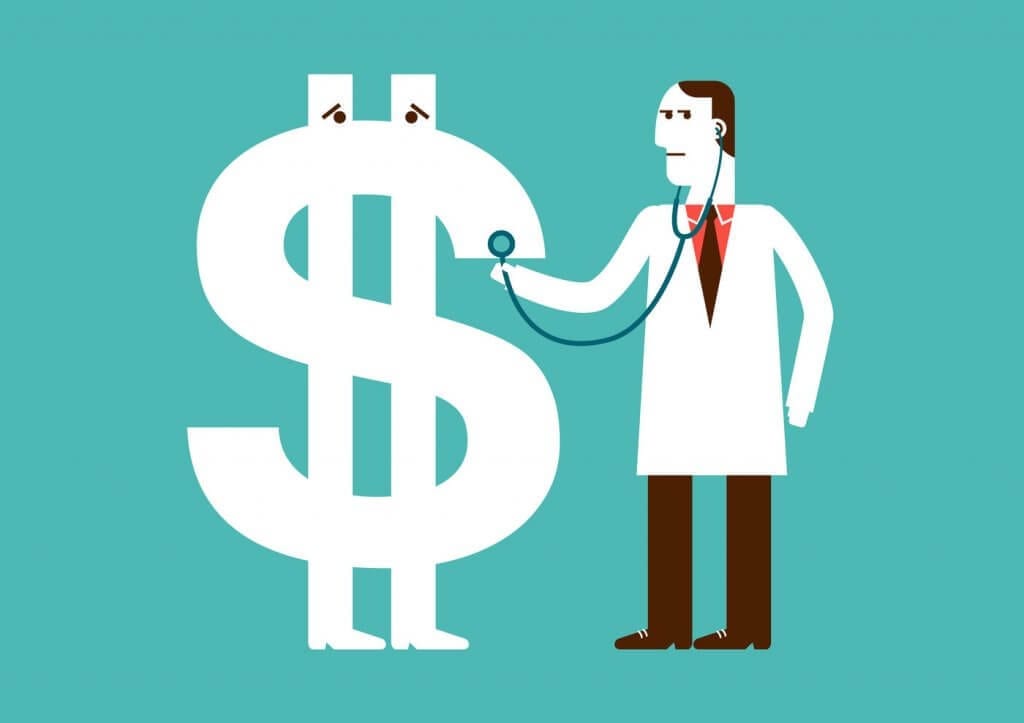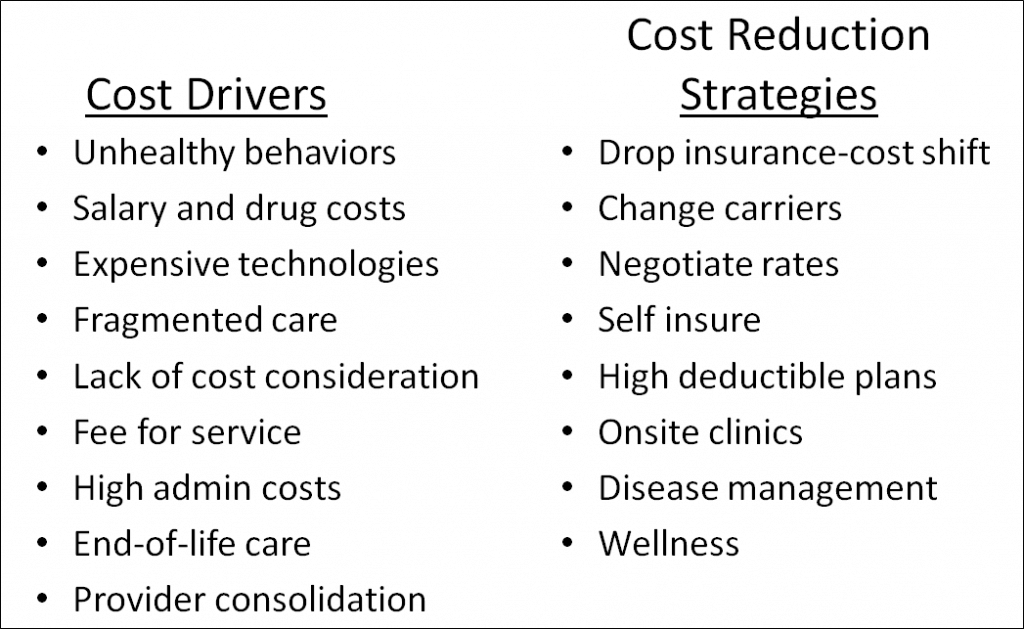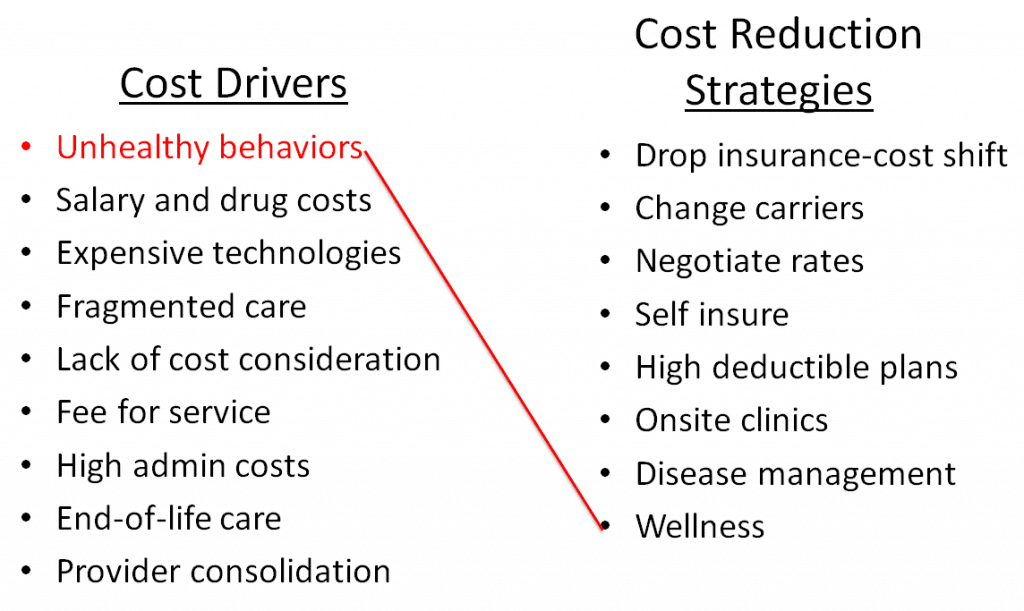Why Lower Health Care Costs is One of the Benefits of Wellness in 2024

The health and chronic disease prevention centers of America are now America’s worksites. There’s not a single group in America that does more to lower health care costs, promote health improve the health behaviors of our population than worksites.
Our current medical system is a disease treatment system. It was created to treat, not prevent, arrest, or reverse health conditions. If you do have disease or existing health problems, the American system of medical care is very good, albeit extremely expensive.
One of the main benefits of wellness in the workplace is to improve employee health and prevent employees from having to use our expensive medical system.
Employee wellness programs can impact employee health, but their direct impact on the high cost of health care is limited because many of the drivers of high healthcare costs are not impacted by wellness programs. We have good research that shows us what the main drivers of healthcare costs are.
Drivers of High Health Care Costs
1. Unhealthy lifestyle behaviors are responsible for most chronic diseases. These diseases cause approximately 70 percent of all deaths and up to 75% of all healthcare costs. Lack of physical activity, poor diets and tobacco use are directly responsible for 70-90% of chronic diseases.
2. Salary and drug costs in the U.S. are the highest in the world. Physicians, nurses, and other healthcare providers make higher salaries than comparable professionals in other industrialized countries. In one company, the cost of medications has increased 27% in the past 12 months. Examples of soaring prices have been reported on multiple media outlets. Pharmaceuticals are the new gold rush.
3. Expensive technologies and procedures such as MRI and CT scanning are medical marvels that come at a steep price. Fearing possible litigation, physicians will practice defensive medicine and order these scans when they are often unwarranted. This is one reason Americans do twice as much imaging as other populations in the industrialized world.
4. Fragmented care refers to the uncoordinated and disconnected care provided by many healthcare facilities. Multiple doctors from different facilities, incompatible records systems, multiple surgeries and duplicate lab tests are common features of our healthcare system. These factors contribute to the duplication of procedures and tests.
5. Lack of cost consideration really refers to lack of cost transparency. Unlike free market transactions where a buyer and a seller agree over a known price, most medical patients have no idea how much things cost.
By having insurance, many people never see the price of goods and services and do not base their decision to purchase based on price. Price is decided between the healthcare provider and the insurance company which makes it easier to increase prices.
6. Fee for service refers to the idea that doctors only get paid when they provide a service—put something in you or take something out of you. Financial incentives are based on quantity of services provided, not quality. Hence, most physicians have direct financial pressure to provide a service whether or not it is needed.
7. High administrative costs exceed $1,100 per person per year. Excluding the actual cost of providing health care, it costs $1,100 per person just to administer health care in the U.S.
8. End-of-life care is the most expensive of all medical care. One out of every four Medicare dollars is spent on end of life care. In 2012, that was $125 billion.
9. Provider consolidation means hospitals and physician groups are banding together with the goal of increasing market share. With each consolidation comes the tendency to increase the cost of services because of reduced competition.

This list of cost drivers is not comprehensive but it does include the most important ones. Worksites may not see or understand how healthcare costs are impacted by these drivers, but they do understand that there are strategies that can be implemented to try and slow cost increases.
Some of these are more effective than others, depending on the worksite.
Strategies to Lower Health Care Costs
1. Drop insurance completely by forcing employees to seek healthcare coverage in the exchanges. Larger employers can pay the federal penalty each year and pass the remaining health care costs directly to the employee.
This is another version of healthcare cost shifting that many companies have considered. This is exactly what Walmart did with it’s 30,000 part time employees. Others are doing the same. If dropping insurance coverage is too bold, you can do what most employers do, pass the cost increase along to your employees.
2. Change insurance carriers/ negotiate better rates in an attempt to get better pricing. Most carriers will negotiate hard to get your business. It may be possible to shave a few percentage points off the cost during year one, but soon after the honeymoon is over, cost increases continue. This strategy is usually a dead end.
3. Self insuring means employers pay for employee healthcare costs directly. With this approach the risk of high healthcare costs is born by the employer. Stop loss policies help protect against catastrophic medical costs.
Once thought to be a strategy of large corporations, there are insurance companies that will self-insure a company with as few as 50 people. This can help reduce approximately 7% of the cost that is associated with administering a fully insured insurance plan.
4. High deductible plans are more popular than ever. They are the ultimate in cost shifting. Some studies have shown that when your employees begin a high deductible healthcare plan, healthcare costs can be reduced by as much as 5-14%.
5. On-site clinics are loved by employees and they may well have a big impact on employee productivity, but it is still unclear if they can actually reduce healthcare costs.
6. Disease management includes strategies to manage the chronic conditions of high-risk, high-cost employees. The research says disease management can improve patient care and may improve health outcomes, but fails to save money.
7. Workplace health programs are one of the most effective and well accepted cost reduction strategies. The government and universities have demonstrated that effective workplace health programs don’t eliminate the drivers of healthcare costs, but they do reduce the demand for healthcare services.
Said another way, workplace health programs help worksites avoid high health care costs because they help employees stay healthy and stay out of the healthcare system.

Workplace health programs will not impact many of the drivers of healthcare costs, but they can impact unhealthy behaviors and this is why reducing health care costs is one of the main benefits of wellness.
By helping employees adopt and maintain healthy behaviors, they improve their health and avoid chronic diseases. Without chronic disease the cost of health care is greatly reduced. Skeptics may doubt this logic, but that is exactly what happens.
Worksites who do wellness program correctly will experience lower health care costs. They experience wellness outcomes that demonstrate improved health behaviors, lower health risks, and dramatically lower health care costs. You can see this evidence here.
For example, Johnson & Johnson’s Wellness Program demonstrated a long-term impact on controlling health care costs by addressing high blood pressure and cholesterol risks through policy, environment, and education. During Johnson & Johnson four-year study, they decreased medical costs by approximately $225 per participating employee per year.
So What?
This last image shows how an effective employee health program can have a direct impact on at least one of the divers of healthcare costs: unhealthy behaviors. One of the benefits of wellness is that comprehensive wellness programs keep people out of the healthcare system.
When you are not in the healthcare system, the drivers of healthcare costs are muted. Reduced health care costs is just one way how wellness programs save money.
FAQs
How Much Does Health Care Typically Cost?
According to eHealth, the average national cost for health insurance in 2020 was $456 for individuals and $1,152 for a family per month. However, these costs vary based on age, location, health status, and plan category.
Why Is Health Care So Expensive?
Health care costs and spending in the United States are on the rise, affecting the budgets of families and businesses. Three key factors driving U.S health care costs are the increase of chronic diseases, unhealthy lifestyles, and expensive pharmaceutical drugs and procedures.
Are Wellness Programs Cost Effective?
A 2019 report by the International Foundation of Employee Benefit Plans found that most employers in North America saved between $1 and $3 in health care costs for every $1 spent on company wellness programs.
If you already have a wellness program in place, or if you are debating whether it will be worth it to start one, click here to use the free WellSteps ROI calculator. It is backed by numerous scientific studies and updated each year to include the most recent findings.
Why Are We Not Able to Control the Costs of Healthcare?
Oh, but we are. The problem is it was previously viewed as something to cut out – or take away from employees. That’s not the right approach. Thankfully, with wellness insurance providers, like WellSteps, it’s now about improving the health of employees that in turn cuts down on health care costs.
Other related articles
THIS IS THE IMPACT OF EMPLOYEE WELLNESS PROGRAMS ON HEALTH CARE COSTS
DO WELLNESS PROGRAMS SAVE MONEY?
WELLNESS ROI VS VOI: THE BEST EMPLOYEE WELL-BEING PROGRAMS USE BOTH







Steve,
Great article. Thanks for writing it and all you are doing. Other cost drivers are poverty (including borderline poverty) and lack of health insurance (at all or inadequate coverages – e.g., high deductibles, co-pays) both of which can become a barrier to getting timely quality care affecting number and severity of risks, problems, related earlier detection, treatment and costs of care to all parties. Living wages and “Living” Health Insurance are part of the solution as well – both aspects of financial wellbeing that is interconnect to the other dimensions of wellbeing.
No doubt in my mind you know all this. I’ve a heart for these issues more than ever in my involvement training community health workers who work with those on Medicare, and experiences with working with employers observing patterns with new hires who may not have had good or any health insurance before starting.
Bob